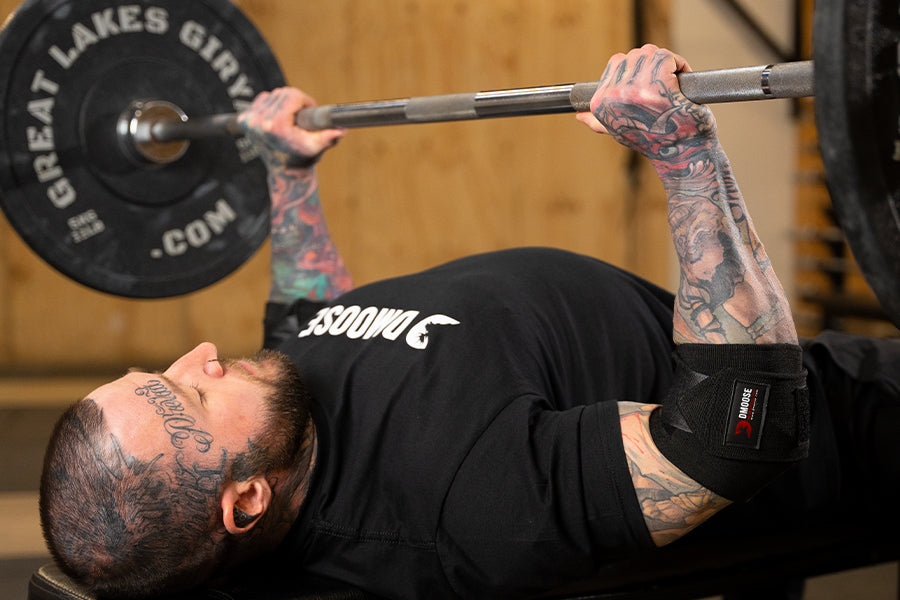When it comes to weightlifting, it is important to understand the varied effects different types of movements can have on your body.
One dilemma many lifters face is whether they should perform their bench presses on an incline or a decline. Both have advantages and drawbacks, so it's essential to understand the difference between them before deciding which one is best for you.
Each has its unique benefits, and knowing how each will affect your workout should help you make an informed decision when planning your next gym session. So, let’s take a look at these bench presses and what the differences are between the two.
Why Bench Press?
The Bench Press is one of the most popular exercises for targeting chest muscles regarding weightlifting. It can be performed in the gym or at home with a barbell and weights, and it is an excellent option for those looking to build muscle and strength while improving their posture.
The Bench Press is efficient because it allows you to lift heavier weights than you typically do on other chest exercises due to its fixed motion path. This exercise recruits more muscles than your chest—like your triceps, shoulders, and lower back, making it an excellent addition to any fitness routine!
Due to its effectiveness and very low difficulty, the bench press has cemented its value as an essential bodybuilding exercise. This makes it more vital to understand the difference between Incline Vs. Decline Bench Press.
Related Article: How to Do the Dumbbell Bench Press: Variations, Muscles Worked, Benefits & More
What is an Incline Bench Press?

Specifically, this exercise works both parts of the pectoralis major muscle: its clavicular head – known informally as an 'upper pec'– and sternocostal head - or 'lower pec.' With regular practice, you'll see improvements in muscular definition across these areas resulting in that sought-after toned physique.
When it comes to equipment, a slight tweak can make all the difference. An adjustable incline bench is ideal for this type of exercise; if necessary, you could use an ordinary flat bench and place some weight plates underneath one end to increase its slant.
- Lay down on the inclined bench at 30 to 45 degrees so that the bench supports your head and your feet are firmly planted on the floor. Position the bar so that it is directly above your face. Contract your glutes as well as your core muscles.
- Put as much pressure as possible into your hold on the bar by using a slightly wider grip than the distance between your shoulders.
- Perform an overhead press to unrack the bar, then bring it directly over your shoulders while maintaining a straight arm position. This will be the position from which we begin.
- While taking a full breath, you should exhale and slowly bring the back of your shoulders down to the top of your chest. Maintain a 45-degree angle between your upper arms and the rest of your body.
- Take a brief pause at the bottom of the movement before bringing the barbell up to your chest. Then drive up through your feet with a powerful explosion.
- Repeat the movement until you have completed the required repetitions while bringing the bar back to the starting position.
Getting into proper form is essential for those looking to maximize their gains during the incline bench press. To ensure that you are feeling your muscles contract and extend throughout each rep, take the time to focus on where tension should be felt: in your upper chest!
Not only will this help produce optimal performance, but it's also important for safety purposes - having either a spotter or safety rack nearby, just in case, can always come in handy if faced with an unexpected heavy weight lift.
Related Article: How to Bench Press With Proper Form: 7 Mistakes That are Killing Your Progress
Benefits of an Incline Bench Press
The incline bench press is arguably one of the best exercises for upper body strength. Whether you are a professional bodybuilder or just trying to stay in shape, this exercise offers numerous benefits, such as the following:
Builds Symmetry
The incline bench press is a great way to build symmetry in your chest and arms. It is one of the most versatile exercises because it works multiple muscle groups at the same time, helping to ensure that everything develops evenly. As you progress, you can include different dumbbells and barbells using different angles and reps to challenge yourself and focus on building muscular balance.
Maintaining a controlled motion with stability throughout your entire body is essential while performing this exercise for the best results. Not only will this help improve symmetry, but it also minimizes the risk of injury from overtaxing one muscle group over another. Incorporating an incline bench press into your workout routine will result in a balanced physique with better posture and increased confidence.
Increases Strength
The Incline Bench Press is a must for any weightlifting routine as it dramatically increases strength. It targets the upper chest, shoulders, and triceps but engages all of the muscles in the chest to some degree. It is an excellent choice for developing upper body strength, as lifting heavier weights stimulates muscle growth.
As with all exercises, proper form is important to reap the full benefits and avoid any potential risk of injury. If done correctly, the incline bench press can be an exceptionally effective way to increase your overall muscle strength.
Isolates Triceps
The incline bench press is one of the most effective exercises for strengthening the chest, shoulders, and triceps. However, it has a unique ability to single out the triceps muscles among these three—meaning that if you want to concentrate on strengthening this muscle group, then the incline bench press is an exercise that is not to be overlooked.
Although all three muscle groups work together to achieve rep success when using this exercise, the triceps are targeted more and tend to tire faster than the other two. Consequently, it is essential for increasing triceps strength and providing a good foundation for additional arm-focused exercises.
Muscles Targeted By the Incline Bench Press
Following are the muscle groups that are targeted from incline bench presses:
Primary Muscles Worked:
Chest
Front Deltoid
Secondary Muscles Worked:
Triceps
What is a Decline Bench Press?

Compared to a flat bench press, the decline variation challenges your chest in new ways. Instead of building up your upper pectorals, you rely more heavily on engaging and strengthening those lower muscles—which tend to be larger and stronger than their counterparts.
If you struggle with pressing heavy weights or want an extra challenge next time at the gym, why not try it?
Decline presses call for a low range of motion while simultaneously working for all primary muscle groups—making them ideal for maximizing strength gains!
Before we get started, it's important to note that despite being widely regarded as safer for your shoulders, the decline bench press still presents its own unique dangers.
If you're not careful, the weights can roll out of your hand because the bar can easily fall into the indentation formed by your chin and neck. That's why rock-solid footing and stability are musts.
- Place your feet firmly around the feet pads and then lie down on the bench declined at 30 to 45 degrees with your head and eyes beneath the barbell. Brace your glutes and your core muscles.
- Maintain a very firm grip on the bar while holding your arms slightly wider than shoulder-width apart and holding onto the bar.
- Unrack the bar by extending your arms to their full length and moving it over your head to the starting position. After that, make sure your elbows are locked.
- After taking a long, deep breath, slowly and carefully bring the bar down until it touches the bottom of your chest.
- After the bar has reached this point, take a brief break, and then while locking your elbows bring it back up to the starting position.
- Repeat until you have completed the required number of sets.
Like the incline bench press, you should strengthen the connection between your mind and muscles by squeezing the bottom of your pecs. For a beginner, this might be challenging, but with the proper training and practice, you'll achieve much better results than you otherwise would.
Benefits of Decline Bench Press
The Decline Bench Press is an excellent all-around exercise for improving upper-body strength and toning. This exercise strengthens your chest, triceps, and shoulder muscles to allow a greater range of motion when lifting heavy weights and ensures the following benefits:
Builds Upper Body Strength
The decline bench press is one of the best exercises you can do to increase your upper-body strength. It focuses primarily on working the lower chest and front deltoids, with secondary emphasis on the triceps. This exercise puts major stress on these muscle groups for maximum growth, meaning that it's a more effective workout than other chest exercises, such as flat or incline presses.
Incorporating decline bench presses into your regular workout routine is an excellent way to intensify your efforts and take your bodybuilding to the next level.
Isolates Your Deltoids
The decline bench press is excellent for working and engaging your deltoids. The decline bench press allows you to isolate the actual movement of your shoulder muscles instead of relying on other body parts to provide momentum.
By angling the bench downwards and using lighter weights, you can target only your deltoids without putting too much pressure on other muscle groups. With regular practice, you can tone and strengthen your shoulder muscles without risking injury. The decline bench press can also help improve your posture by developing good habits that support proper alignment and balance.
Corrects Your Form
The decline bench press is a fantastic exercise for overall chest strength and offers multiple structural balance benefits. The inclined angle at which you perform the exercise encourages your body to use the correct form while optimizing muscular control and stability. This can lead to better physical performance in other exercises, allowing you to lift heavier weights with increased confidence and safety.
Not only will this reduce strain on weaker muscles or joints that may be prone to injury, but it will help build explosive power and functional strength in the necessary areas so that you can continue working out for years to come!
Muscles Targeted By the Decline Bench Press
Following are the muscle groups that are targetted from declined bench presses:
Primary Muscles Worked:
Lower Chest
Deltoids
Secondary Muscles Worked:
Triceps
The Bottom Line
Fitness enthusiasts are often engaged in a heated debate regarding the benefits of an incline bench press compared to those when using a decline. Though each has its unique advantages, it ultimately depends on your workout routine, which is more advantageous for you.
However, if you're looking to address any strength imbalances and break through training plateaus while adding some variety into the mix, then focus on utilizing both exercises! Doing so can help ensure that your upper chest gets all the attention it needs – making sure that it looks stronger and feels better than ever.
If you are already performing exercises on the flat bench, such as push-ups or the dumbbell bench press, consider incorporating the incline bench into your workout routine and vice-versa. So experiment around and find the one that suits you best.








